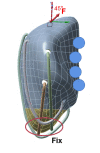Candy box technique for the fixation of inferior pole patellar fractures: finite element analysis and biomechanical experiments
- PMID: 37872511
- PMCID: PMC10594795
- DOI: 10.1186/s12891-023-06946-1
Candy box technique for the fixation of inferior pole patellar fractures: finite element analysis and biomechanical experiments
Abstract
Background: Maintaining effective reduction and firm fixation in inferior pole patellar fractures is a highly challenging task. There are various treatment methods available; although tension-band wiring combined with cerclage wiring (TBWC) is the mainstream approach, its effectiveness is limited. Herein, we propose and evaluate a new technique called candy box (CB), based on separate vertical wiring (SVW), for the treatment of inferior pole patellar fractures. Specifically, we provide biomechanical evidence for its clinical application.
Methods: Five fixation models were built: SVW combined with cerclage wiring (SVWC); TBWC; modified SVW with the middle (MSVW-A) or upper (MSVW-B) 1/3 of the steel wire reserved, and CB. A finite element analysis was performed to compare the displacement and stress under 100-N, 200-N, 300-N, 400-N and 500-N force loads. Three-dimensional printing technology was utilized to create fracture models, and the average displacement of each model group was compared under a 500-N force.
Results: The results of the finite element analysis indicate that CB technology exhibits significantly lower maximum displacement, bone stress, and wire stress compared to that with other technologies under different loads. Additionally, in biomechanical experiments, the average force displacement in the CB group was significantly smaller than that with other methods under a 500-N force (P < 0.05).
Conclusions: CB technology has the potential to overcome the limitations of current techniques due to its superior biomechanical characteristics. By incorporating early functional exercise and ensuring strong internal fixation, patient prognosis could be enhanced. However, further clinical trials are needed to fully evaluate the therapeutic effects of CB technology.
Keywords: Biomechanical experiments; Candy box technique; Finite element analysis; Fracture; Inferior Pole of the patella; Knee.
© 2023. BioMed Central Ltd., part of Springer Nature.
Conflict of interest statement
The authors declare no competing interests.
Figures









References
MeSH terms
Grants and funding
LinkOut - more resources
Full Text Sources
Medical

